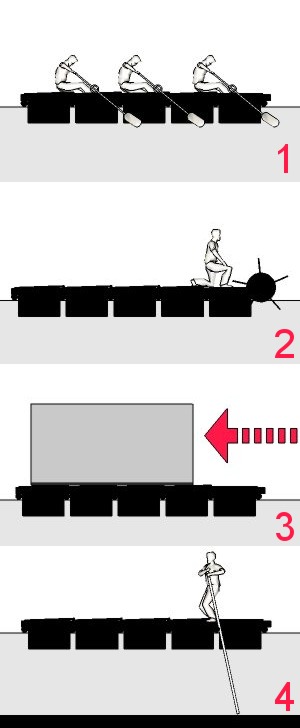 When it comes to moving your raft around, there are 4 realistic options available to you: rowing/paddling, paddlewheels, sailing and punting. I'll take a look at all 4 options briefly.
When it comes to moving your raft around, there are 4 realistic options available to you: rowing/paddling, paddlewheels, sailing and punting. I'll take a look at all 4 options briefly.1. Rowing and Paddling. Paddling uses either a single or double-bladed paddle, and the paddler faces in the direction of travel. Rowing is the use of a single-bladed oar, which is normally held in a crutch and the rower faces towards the back of the raft. Paddles are probably the simplest way of moving your raft around in deep water. The down side is that you can get tired fairly quickly. Rowing with oars is a lot more efficient and potentially pretty fast. The complications here is that you need to sort out decent crutches for this to work. If yo uare a Sea Scout troop, you probably have access to oars and the experience to use them effectively.
2.Paddlewheels. Inspired by Mississippi steamboats,paddlewheels are a very efficient way of moving around, but need a lot of preparation and design beforehand. Paddlewheels are the only piece of the raft that may be pre-constructed for the Gauteng Kontiki competition. Numerous designs are possible, using metals construction or pure pioneering. The paddlewheel shown here is the design of Graham and Gregory Witt and is described here. A pair of paddlewheels placed side-by-side makes a raft easy to steer- it's even possible to turn on the spot. Learn from my mistakes: fasten your paddlewheels AFTER you have launched your raft, it saves you destroying the wheel as you push your raft into the water
Rowing or paddling and paddlewheeling are primary locomotion methods- they can be used at all times to move a raft around. The last two methods I discuss are only useful in certain situations.
3. Sailing. Basically, I am only going to describe the use of a sail when the wind is directly behind you- what sailors call a run. ANY kind of sail you can improvise will help you here: a sheet, a tent (which is what the above drawing uses), a powerkite. Simply raise your sail whenever the wind is travelling in the same direction as you, and lower it at all other times. To sail with the wind coming from any other quarter needs a centreboard of some kind, as well as a rudder.I have only ever seen this attempted once (and I'm unsure whether it was successful). If you are an experienced sailor, by all means try this, please let me know what you come up with.
4. Punting. The final method is for moving in shallow water. Punting is the use of a pole to move the raft by pushing off the bed of the body of water. A comfortable length for a punting pole is 3.5-4m (10-12 feet), and the idea is to push the pole in at a slight backwards angle, as shown in the drawing, then push it backwards and lift it out before the angle gets to large- otherwise it tends to stick. Punting can be very fast, in fact it is probably the fastest method of moving around over short distances. So long as you are in shallow water, two scouts should be punting your raft- one on either side. Punting originated in England on the Thames, and there are a few good tips on punting traditional Thames punts here.
These are the most common methods for propelling a raft, there are others that are less efficient: pushing it while swimming behind, towing it with a canoe or gig, 'inchworming' with an anchor by casting far and then pulling yourself across to the anchor position, to repeat the same action, or using an outboard motor. A word of caution: outboard motors are pretty dangerous pieces of equipment, I recommend you only try using one under the supervision of someone who is experienced in their use, paying special attention to securely mounting it.
Kontiki starts on Friday. I will photograph what I can and report back over the next couple of days about the things I've seen.

No comments:
Post a Comment